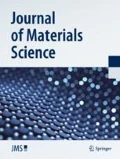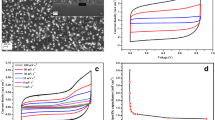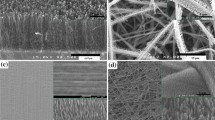Abstract
We devised a simple and effective method of electrochemical functionalization of horizontally aligned CNT films in diluted HCl and H2SO4 solutions upon their electrolysis under a constant current mode. We were able to cause notable generation of carbon–oxygen and carbon–chlorine functional groups on the CNT film anodes as proven by EDX, XPS, and Raman spectroscopy. As a consequence, we observed significant changes of the morphology of the material under electron microscopy, what translated into improved compatibility of CNTs with hydrophilic media. In turn, application of CNT films as cathodes was found as a powerful tool for a thorough cleaning of the nanotubes. Finally, we demonstrated that by the selection of appropriate conditions, CNT films can act as easy-to-make and flexible electrodes with a high stability and performance superior to graphite for generation of non-oxidizing gases such as hydrogen from solution. CNT film electrodes are two orders of magnitude lighter and require much lower overpotential for faradaic splitting of water.








Similar content being viewed by others
References
Zhou CW, Kong J, Dai HJ (2000) Intrinsic electrical properties of individual single-walled carbon nanotubes with small band gaps. Phys Rev Lett 84(24):5604–5607. doi:10.1103/PhysRevLett.84.5604
Charlier JC, Blase X, Roche S (2007) Electronic and transport properties of nanotubes. Rev Mod Phys 79(2):677–732. doi:10.1103/RevModPhys.79.677
Hong S, Myung S (2007) Nanotube electronics: a flexible approach to mobility. Nat Nanotechnol 2(4):207–208. doi:10.1038/nnano.2007.89
Hone J, Whitney M, Piskoti C, Zettl A (1999) Thermal conductivity of single-walled carbon nanotubes. Phys Rev B 59(4):R2514–R2516. doi:10.1103/PhysRevB.59.R2514
Pop E, Mann D, Wang Q, Goodson KE, Dai HJ (2006) Thermal conductance of an individual single-wall carbon nanotube above room temperature. Nano Lett 6(1):96–100. doi:10.1021/Nl052145f
Treacy MMJ, Ebbesen TW, Gibson JM (1996) Exceptionally high Young’s modulus observed for individual carbon nanotubes. Nature 381(6584):678–680. doi:10.1038/381678a0
Yu MF, Files BS, Arepalli S, Ruoff RS (2000) Tensile loading of ropes of single wall carbon nanotubes and their mechanical properties. Phys Rev Lett 84(24):5552–5555. doi:10.1103/PhysRevLett.84.5552
Datsyuk V, Kalyva M, Papagelis K, Parthenios J, Tasis D, Siokou A, Kallitsis I, Galiotis C (2008) Chemical oxidation of multiwalled carbon nanotubes. Carbon 46(6):833–840. doi:10.1016/j.carbon.2008.02.012
Moraes FC, Cabral MF, Mascaro LH, Machado SAS (2011) The electrochemical effect of acid functionalisation of carbon nanotubes to be used in sensors development. Surf Sci 605(3–4):435–440. doi:10.1016/j.susc.2010.11.014
Marques RRN, Machado BF, Faria JL, Silva AMT (2010) Controlled generation of oxygen functionalities on the surface of single-walled carbon nanotubes by HNO3 hydrothermal oxidation. Carbon 48(5):1515–1523. doi:10.1016/j.carbon.2009.12.047
Xia W, Yin XL, Kundu S, Sanchez M, Birkner A, Woll C, Muhler M (2011) Visualization and functions of surface defects on carbon nanotubes created by catalytic etching. Carbon 49(1):299–305. doi:10.1016/j.carbon.2010.09.025
Grujicic M, Cao G, Rao AM, Tritt TM, Nayak S (2003) UV-light enhanced oxidation of carbon nanotubes. Appl Surf Sci 214(1–4):289–303. doi:10.1016/S0169-4332(03)00361-1
Savage T, Bhattacharya S, Sadanadan B, Gaillard J, Tritt TM, Sun YP, Wu Y, Nayak S, Car R, Marzari N, Ajayan PM, Rao AM (2003) Photoinduced oxidation of carbon nanotubes. J Phys 15(35):5915–5921. doi:10.1088/0953-8984/15/35/301 Pii S0953-8984(03)60152-9
Colomer JF, Marega R, Traboulsi H, Meneghetti M, Van Tendeloo G, Bonifazi D (2009) Microwave-assisted bromination of double-walled carbon nanotubes. Chem Mater 21(20):4747–4749. doi:10.1021/Cm902029m
Vazquez E, Prato M (2009) Carbon nanotubes and microwaves: interactions, responses, and applications. ACS Nano 3(12):3819–3824. doi:10.1021/Nn901604j
Liu CM, Cao HB, Li YP, Xu HB, Zhang Y (2006) The effect of electrolytic oxidation on the electrochemical properties of multi-walled carbon nanotubes. Carbon 44(14):2919–2924. doi:10.1016/j.carbon.2006.05.046
Balasubramanian K, Burghard M (2008) Electrochemically functionalized carbon nanotubes for device applications. J Mater Chem 18(26):3071–3083. doi:10.1039/B718262g
Ohmori S, Saito T (2012) Electrochemical durability of single-wall carbon nanotube electrode against anodic oxidation in water. Carbon 50(13):4932–4938. doi:10.1016/j.carbon.2012.06.023
Komarova NS, Krivenko AG, Ryabenko AG, Naumkin AV, Stenina EV, Sviridova LN (2012) Spectroscopic characterization of the electrochemical functionalization of single-walled carbon nanotubes in aqueous and organic media. Carbon 50(3):922–931. doi:10.1016/j.carbon.2011.09.054
Komarova NS, Krivenko AG, Ryabenko AG, Naumkin AV (2013) Active forms of oxygen as agents for electrochemical functionalization of SWCNTs. Carbon 53:188–196. doi:10.1016/j.carbon.2012.10.047
Unger E, Graham A, Kreupl F, Liebau M, Hoenlein W (2002) Electrochemical functionalization of multi-walled carbon nanotubes for solvation and purification. Curr Appl Phys 2(2):107–111. doi:10.1016/S1567-1739(01)00072-4
Rafailov PM, Thomsen C, Monev M, Dettlaff-Weglikowska U, Roth S (2008) Electrochemical functionalization of SWNT bundles in acid and salt media as observed by Raman and X-ray photoelectron spectroscopy. Phys Status Solidi B 245(10):1967–1970. doi:10.1002/pssb.200879569
Li YL, Kinloch IA, Windle AH (2004) Direct spinning of carbon nanotube fibers from chemical vapor deposition synthesis. Science 304(5668):276–278. doi:10.1126/science.1094982
Koziol K, Vilatela J, Moisala A, Motta M, Cunniff P, Sennett M, Windle A (2007) High-performance carbon nanotube fiber. Science 318(5858):1892–1895. doi:10.1126/science.1147635
Boccaccini AR, Cho J, Roether JA, Thomas BJC, Jane Minay E, Shaffer MSP (2006) Electrophoretic deposition of carbon nanotubes. Carbon 44(15):3149–3160. doi:10.1016/j.carbon.2006.06.021
Shimada T, Yanase H, Morishita K, Hayashi J-I, Chiba T (2004) Points of onset of gasification in a multi-walled carbon nanotube having an imperfect structure. Carbon 42(8–9):1635–1639. doi:10.1016/j.carbon.2004.02.019
Ago H, Kugler T, Cacialli F, Salaneck WR, Shaffer MSP, Windle AH, Friend RH (1999) Work functions and surface functional groups of multiwall carbon nanotubes. J Phys Chem B 103(38):8116–8121. doi:10.1021/Jp991659y
Datsyuk V, Guerret-Piecourt C, Dagreou S, Billon L, Dupin JC, Flahaut E, Peigney A, Laurent C (2005) Double walled carbon nanotube/polymer composites via in situ nitroxide mediated polymerisation of amphiphilic block copolymers. Carbon 43(4):873–876. doi:10.1016/j.carbon.2004.10.052
Janas D, Koziol KK (2013) Rapid electrothermal response of high-temperature carbon nanotube film heaters. Carbon 59:457–463. doi:10.1016/j.carbon.2013.03.039
Boncel S, Sundaram RM, Windle AH, Koziol KKK (2011) Enhancement of the mechanical properties of directly spun CNT fibers by chemical treatment. ACS Nano 5(12):9339–9344. doi:10.1021/Nn202685x
Britto PJ, Santhanam KSV, Rubio A, Alonso JA, Ajayan PM (1999) Improved charge transfer at carbon nanotube electrodes. Adv Mater 11(2):154–157. doi:10.1002/(SICI)1521-4095(199902)11:2<154:AID-ADMA154>3.0.CO;2-B
Herraiz-Cardona I, González-Buch C, Ortega E, García-Antón J, Pérez-Herranz V (2013) Energy efficiency improvement of alkaline water electrolysis by using 3D Ni cathodes fabricated via a double-template electrochemical process. Chem Eng Trans 32:451–456
Dresselhaus MS, Dresselhaus G, Jorio A, Souza AG, Saito R (2002) Raman spectroscopy on isolated single wall carbon nanotubes. Carbon 40(12):2043–2061. doi:10.1016/S0008-6223(02)00066-0
Jorio A, Pimenta MA, Souza AG, Saito R, Dresselhaus G, Dresselhaus MS (2003) Characterizing carbon nanotube samples with resonance Raman scattering. New J Phys 5:139. doi:10.1088/1367-2630/5/1/139
Khantimerov SM, Shustov VA, Kurbatova NV, Kukovitsky EF, Matukhin VL, Sakhratov YA, Suleimanov NM (2013) Effect of electrochemical treatment on structural properties of conical carbon nanotubes. Appl Phys A 113:1–6. doi:10.1007/s00339-013-7697-0
Jang WS, Chae SS, Lee SJ, Song KM, Baik HK (2012) Improved electrical conductivity of a non-covalently dispersed graphene-carbon nanotube film by chemical p-type doping. Carbon 50(3):943–951. doi:10.1016/j.carbon.2011.09.057
Das A, Pisana S, Chakraborty B, Piscanec S, Saha SK, Waghmare UV, Novoselov KS, Krishnamurthy HR, Geim AK, Ferrari AC, Sood AK (2008) Monitoring dopants by Raman scattering in an electrochemically top-gated graphene transistor. Nat Nanotechnol 3(4):210–215. doi:10.1038/nnano.2008.67
Ko HH, Pikus Y, Jiang CY, Jauss A, Hollricher O, Tsukruk VV (2004) High-resolution Raman microscopy of curled carbon nanotubes. Appl Phys Lett 85(13):2598–2600. doi:10.1063/1.1795981
Exner O, Bohm S (2002) Bond angles and bond lengths in monosubstituted benzene and ethene derivatives: a comparison of computational and crystallographic results. Acta Crystallogr B 58:877–883. doi:10.1107/S0108768102010510
Moye CJ, Sternhell S (1964) The degradation of aromatic rings: the action of hypochlorite on phenol. Tetrahedron Lett 5(35):2411–2417. doi:10.1016/S0040-4039(00)76325-8
Atkins PW (1998) Physical chemistry, 6th edn. Freeman, New York
Drogui P, Elmaleh S, Rumeau M, Bernard C, Rambaud A (2001) Hydrogen peroxide production by water electrolysis: application to disinfection. J Appl Electrochem 31(8):877–882. doi:10.1023/A:1017588221369
Campos-Martin JM, Blanco-Brieva G, Fierro JLG (2006) Hydrogen peroxide synthesis: an outlook beyond the anthraquinone process. Angew Chem Int Edit 45(42):6962–6984. doi:10.1002/anie.200503779
Petigara BR, Blough NV, Mignerey AC (2002) Mechanisms of hydrogen peroxide decomposition in soils. Environ Sci Technol 36(4):639–645. doi:10.1021/Es001726y
Nadezhdin AD (1988) Mechanism of ozone decomposition in water: the role of termination. Ind Eng Chem Res 27(4):548–550. doi:10.1021/Ie00076a002
Bart SC, Lobkovsky E, Chirik PJ (2004) Preparation and molecular and electronic structures of iron(0) dinitrogen and silane complexes and their application to catalytic hydrogenation and hydrosilation. J Am Chem Soc 126(42):13794–13807. doi:10.1021/Ja046753t
Yu RP, Darmon JM, Hoyt JM, Margulieux GW, Turner ZR, Chirik PJ (2012) High-activity iron catalysts for the hydrogenation of hindered, unfunctionalized alkenes. Acs Catal 2(8):1760–1764. doi:10.1021/Cs300358m
Wang TX, Margerum DW (1994) Kinetics of reversible chlorine hydrolysis: temperature-dependence and general acid base-assisted mechanisms. Inorg Chem 33(6):1050–1055. doi:10.1021/Ic00084a014
Liu ZF, Siu CK, Tse JS (1999) Catalysis of the reaction HCl + HOCl → H2O + Cl2 on an ice surface. Chem Phys Lett 309(5–6):335–343. doi:10.1016/S0009-2614(99)00683-1
Yu HO, Zhang ZJ, Wang Z, Jiang ZW, Liu J, Wang L, Wan D, Tang T (2010) Double functions of chlorinated carbon nanotubes in its combination with Ni2O3 for reducing flammability of polypropylene. J Phys Chem C 114(31):13226–13233. doi:10.1021/Jp104216r
Janas D, Vilatela AC, Koziol K (2013) Performance of carbon nanotube wires in extreme conditions. Carbon 62:438–446. doi:10.1016/j.carbon.2013.06.029
Gonzalez-Dominguez JM, Castell P, Bespin-Gascon S, Anson-Casaos A, Diez-Pascual AM, Gomez-Fatou MA, Benito AM, Maser WK, Martinez MT (2012) Covalent functionalization of MWCNTs with poly(p-phenylene sulphide) oligomers: a route to the efficient integration through a chemical approach. J Mater Chem 22(39):21285–21297. doi:10.1039/C2jm35272a
Cingil HE, Balmer JA, Armes SP, Bain PS (2010) Conducting polymer-coated thermally expandable microspheres. Polym Chem 1(8):1323–1331. doi:10.1039/C0py00108b
Werder T, Walther JH, Jaffe RL, Halicioglu T, Noca F, Koumoutsakos P (2001) Molecular dynamics simulation of contact angles of water droplets in carbon nanotubes. Nano Lett 1(12):697–702. doi:10.1021/Nl015640u
Janas D, Sundaram R, Koziol KKK (2012) Surface modification of directly spun carbon nanotube films. Mater Lett 79:32–34. doi:10.1016/j.matlet.2012.03.090
Cassie ABD, Baxter S (1944) Wettability of porous surfaces. T Faraday Soc 40:0546–0550. doi:10.1039/Tf9444000546
Acknowledgements
D.J. and K.K. acknowledge the European Research Council (under the Seventh Framework Program FP7/2007–2013, ERC Grant Agreement No 259061) and the Royal Society for the financial support. S.B. is greatly indebted to the Foundation for Polish Science in the framework of KOLUMB Program (FNP-DS-402–7410/2012/Kf), Ministry of Science and Higher Education in Poland (IP2012 003572) in the framework of IUVENTUS PLUS Program and National Science Centre in Poland in the framework of SONATA (2012/05/D/ST5/03519) for financing the research. X-ray photoelectron spectra were obtained at the National EPSRC XPS User’s Service (NEXUS) at Newcastle University, an EPSRC Mid-Range Facility.
Author information
Authors and Affiliations
Corresponding author
Electronic supplementary material
Below is the link to the electronic supplementary material.
Rights and permissions
About this article
Cite this article
Janas, D., Kreft, S.K., Boncel, S. et al. Durability and surface chemistry of horizontally aligned CNT films as electrodes upon electrolysis of acidic aqueous solution. J Mater Sci 49, 7231–7243 (2014). https://doi.org/10.1007/s10853-014-8430-x
Received:
Accepted:
Published:
Issue Date:
DOI: https://doi.org/10.1007/s10853-014-8430-x




